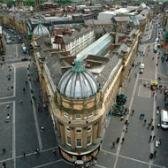Region: North East
Local Authority: Newcastle upon Tyne
Owner Type: Many
Funding Body: English Heritage (HERS); English Partnerships; One North East; Newcastle City Council; Public and Private
Year of Intervention: 1997 - 2003
Summary: The Grainger Town regeneration project has revitalised the historic heart of the City of Newcastle upon Tyne, giving the city-centre a new sense of purpose and self confidence.
Description: Grainger Town is the historic heart of the City of Newcastle upon Tyne. It covers approximately 36 hectares and comprises a complex mix of offices, retail, residential, leisure and cultural uses. It takes its name from the series of elegant streets of 'Tyneside Classical' architecture that was conceived as a whole and built by Richard Grainger between 1835 and 1842. It also includes a 13th century Dominican Friary, remnants of the old town walls and many fine Victorian buildings. Virtually all the area is included within Newcastle's Central Conservation Area. Of its 640 buildings, 244 (40%) are listed, of which 12% are grade I and 20% grade II*.
Issue: Although affluent, fashionable and thriving in the 19th century, by the late 20th century Grainger Town was exhibiting many symptoms of urban decay and economic and social decline. This was including decaying listed buildings, half of which were deemed to be 'at risk'; over one million square feet of vacant floorspace; neglected upper floors; poor environment and low standards in the public realm, and a lack of developer, investor and occupier confidence. Perceptions of the city centre were at an all-time low.
Strategy: In 1997, the Grainger Town Regeneration Project led by Grainger Town Partnership was established with the aim of addressing the underlying causes of decline. It was identified in 1996 that there were 4,150 young or long-term unemployed people in the economically disadvantaged wards of Newcastle and there was a low skills base. Furthermore Grainger Town had not been a focus for business development activity. The Grainger Town regeneration project was supported by English Heritage, English Partnership/One North East and Newcastle City Council and ran until March 2003. This included the Grainger Town CAPS (Conservation Area Partnership Scheme) that ended in 1999, followed by a three-year Heritage Economic Regeneration Scheme (HERS). The HERS aimed to assist the social and economic regeneration of New Castle upon Tyne through the conservation and enhancement of specific building at risk within the conservation area that were identified in the 1996 survey of Grainger Town. Eligible works for discretionary grant aid included general structural repairs, specialist treatments and reinstatement of architectural features.
Outcome:
The Grainger Town HERS has been successful in rescuing or assisting the repair and conservation of numerous buildings at risk. This means that the magnificent architectural heritage and unique assemblages of space which make up Grainger Town have received the attention and care they deserve. This has improved the environment and revitalised business, social and cultural life. The success of the overall project was recognised by a best practice award from the British Urban Regeneration Association for excellence in regeneration and a commendation by the Royal Town Planning Institute. It is also seen as a major contributor towards the Newcastle Gateshead European Capital of Culture 2008 bid. On the 31st March 2003, the regeneration project closed, having achieved and exceeded its objectives. However a number of major capital schemes will continue as well as Public Art and Lighting schemes. Responsibility for the future maintenance and improvement of the area, and on-going schemes, will transfer to the City Centre Panel, supported by the City Centre Development Team, Planning and Transportation Division and Newcastle City Council.
Keywords: FUNDING, REGENERATION, REPAIR RECONSTRUCTION & RESTORATION
© English Heritage

